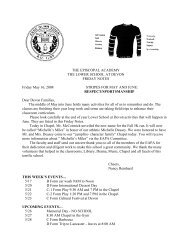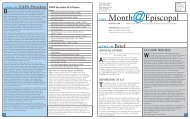Fostering Lifelong Learning - Episcopal Academy
Fostering Lifelong Learning - Episcopal Academy
Fostering Lifelong Learning - Episcopal Academy
Create successful ePaper yourself
Turn your PDF publications into a flip-book with our unique Google optimized e-Paper software.
Development<br />
Charitable Lead Trusts —<br />
A Welcome Contribution to Ever <strong>Episcopal</strong><br />
John. J. F. Sherrerd '47, retired<br />
investment banker, generous<br />
benefactor, and Ever <strong>Episcopal</strong><br />
Campaign Co-Chair, has used a<br />
charitable lead trust in the past.<br />
He offers this comment: "For a<br />
supporter of The <strong>Episcopal</strong> <strong>Academy</strong>,<br />
a lead trust can be gratifying<br />
because of the direct and immediate<br />
benefit to the school. You can see<br />
and experience the results of your<br />
gift during your lifetime."<br />
In what is regarded as one of the largest single gifts to an<br />
American independent school, George School in Newtown,<br />
PA was awarded an extraordinary donation from<br />
an alumna in September 2007. The school reportedly will<br />
receive payments that will total $128.5 million over a period of<br />
twenty years from a charitable lead trust. What, you may ask,<br />
is a charitable lead trust<br />
A charitable lead trust (CLT) is a powerful way to transfer<br />
assets to your heirs at significantly reduced gift and estate tax<br />
cost, while supporting one or more charities with income payments<br />
for a period of years. If you want to help finance capital<br />
gifts during your lifetime but also want to transfer assets to<br />
your family at greatly reduced transfer costs, consider a lead<br />
trust. (A lead trust may also be designed to return assets to<br />
the grantor. This article focuses on the more common type,<br />
the non-grantor lead trust.) Because the income payments provide<br />
current, not deferred, support to a nonprofit, it is the only<br />
planned gift that can help finance a construction project.<br />
Briefly, this is how a non-grantor lead trust works: You place<br />
assets in a trust and direct that income distributions go to EA to<br />
finance a project of your choice. After a set period of time, the<br />
assets are transferred to the trust beneficiaries—often children<br />
or grandchildren—at reduced estate or gift tax rates.<br />
Lead trusts are timely now for four reasons.<br />
• Individuals may support philanthropic projects today while<br />
still transferring assets to their heirs. Thanks to new campus<br />
construction, there are many projects currently on EA’s drawing<br />
board. Lead trusts provide current support of <strong>Episcopal</strong> so<br />
you can see the results of your gifts.<br />
• For gift and estate tax purposes, assets are valued as of the<br />
date of the trust. If you fund the trust with assets that appreciate<br />
over the life of the trust, such as stock or commercial real<br />
estate, any appreciation will pass tax-free to your heirs.<br />
• A lead trust can be used to make pledge payments. If you’ve<br />
already made a commitment, you can use the trust income to<br />
pay your pledge payments.<br />
• The IRS discount rate (more formally known as the Section<br />
7520 rate) dropped to 4.4% for January 2008—the lowest the<br />
rate has been since December 2004. The IRS uses a special discount<br />
rate to calculate the present value of remainder interests<br />
left by charitable trusts. Published monthly, the Section 7520<br />
rate is based on the federal mid-term interest rate. The lower<br />
the IRS discount rate, the lower the calculated remainder value<br />
of a trust. In the case of a Charitable Lead Trust, where the<br />
remainder value goes to heirs, a lower discount rate translates<br />
into lower gift and estate taxes.<br />
Example: Cliff has an estate in the 45 percent federal tax<br />
bracket. His son will be in that bracket, too. For each $100,000<br />
he leaves to his son off the top of his estate, Uncle Sam will get<br />
$45,000 and his son will get $55,000. Then, when the $55,000<br />
passes from his son to the grandchildren, Uncle Sam may take<br />
another 45 percent, or $24,750, depending on the estate and<br />
gift taxes at that time. So the original $100,000 will shrink to<br />
$30,250<br />
To minimize the tax bite and to help us, Cliff creates a<br />
$400,000 lead trust that will pay us 7 percent of its initial value,<br />
or $28,000, for 20 years—for a total of $560,000. When<br />
the trust ends, the principal will go to Cliff’s son. Based upon a<br />
4.4 percent IRS discount rate, this plan will result in a $367,400<br />
gift tax deduction. In other words, Cliff’s lead trust will reduce<br />
the transfer tax burden on $400,000 by 92 percent. If assets<br />
have appreciated during the life of the trust, his son stands to<br />
inherit considerably more than the original<br />
$400,000—all at minimal transfer<br />
cost.<br />
This is just one example. The size of the<br />
trust, its term and type and the annual<br />
payout are up to you. For more information,<br />
contact Carolyn Jaeger, Director<br />
of Planned Giving, at 610-617-2252 or<br />
jaeger@episcopalacademy.org.<br />
This information is provided as an educational<br />
service and is not intended as financial or legal advice,<br />
either in whole or in part. Consult your legal<br />
or tax advisor before making any decision regarding<br />
this information.<br />
28 Connections

















